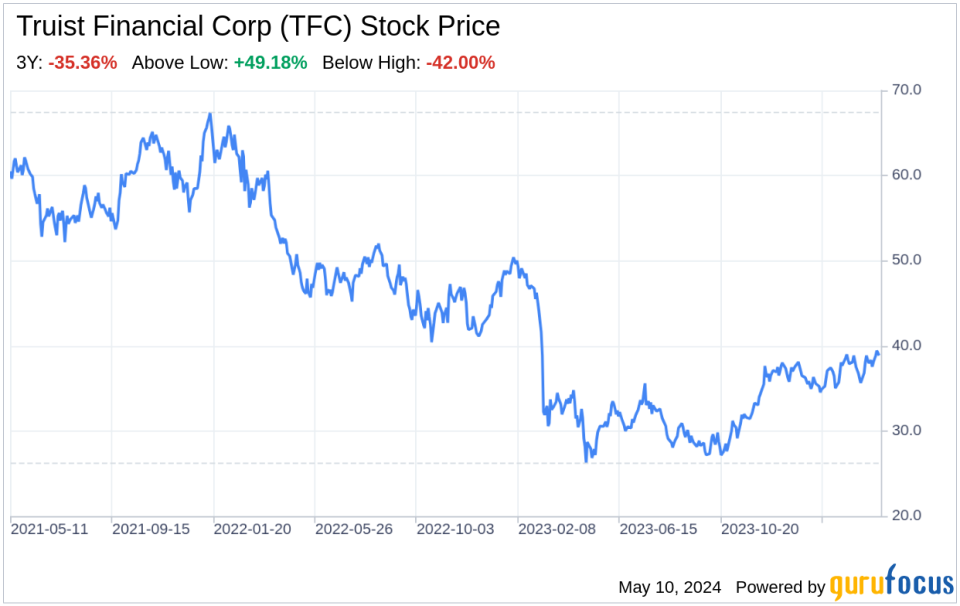Decoding Truist Financial Corp (TFC): A Strategic SWOT Insight
Truist Financial Corp demonstrates robust net interest income despite market challenges.
Opportunities in strategic realignments and divestitures to enhance focus on core segments.
Legal proceedings and regulatory scrutiny pose potential threats to financial stability.
Strong capital ratios position Truist Financial Corp well for regulatory compliance and future growth.
Truist Financial Corp (NYSE:TFC), a leading financial institution headquartered in Charlotte, North Carolina, has released its 10-Q filing on May 9, 2024. This SWOT analysis delves into the company's financial performance and strategic positioning based on the latest SEC filings. Truist, formed from the merger of BB&T and SunTrust, operates primarily in the Southeastern United States, offering a range of services from commercial to retail banking, and investment banking. The company also has a significant nonbank segment, primarily its insurance brokerage business. The financial overview for the first quarter of 2024 reveals a net interest income of $3,372 million, a slight decrease from the previous year's $3,867 million, with a net income of $1,200 million compared to $1,515 million in 2023. Despite these fluctuations, Truist maintains a strong financial foundation, with a CET1 ratio of 10.1%, indicating a solid capital position.

Strengths
Brand and Market Presence: Truist Financial Corp benefits from a strong brand presence and a loyal customer base in the Southeastern U.S., which is a result of the successful merger between BB&T and SunTrust. The company's established market presence is reflected in its substantial net interest income of $3,372 million for the first quarter of 2024, despite a competitive banking landscape. This strength is crucial as it provides a stable foundation for revenue generation and client retention.
Capital Adequacy: Truist's capital ratios remain robust, with a CET1 ratio of 10.1% as of March 31, 2024, which is consistent with the previous quarter and well above the regulatory requirements for well-capitalized banks. This strong capital position enables Truist to absorb potential losses, invest in growth opportunities, and return value to shareholders through dividends, as evidenced by the common dividends declared at $0.52 per share during the first quarter of 2024.
Weaknesses
Declining Net Income: Truist's net income has seen a decline from $1,515 million in the first quarter of 2023 to $1,200 million in the same period of 2024. This reduction in profitability could be attributed to various factors, including market volatility and increased competition, which may impact investor confidence and the company's ability to attract new business.
Legal and Regulatory Challenges: The company faces legal proceedings, such as the Bickerstaff v. SunTrust Bank case, with potential class-wide damages and pre-judgment interest estimated to be significant. Additionally, regulatory scrutiny, as mentioned in the filing, could lead to increased compliance costs and affect the company's reputation and financial performance.
Opportunities
Strategic Realignments: Truist has undertaken strategic realignments, such as renaming and restructuring its operating segments, which could lead to more focused and efficient operations. The realignment of the Wealth business into the Wholesale Banking segment and the small business banking client segmentation into the Consumer and Small Business Banking segment may provide opportunities for enhanced service offerings and revenue growth.
Divestitures and Capital Deployment: The sale of equity interests in TIH represents a material strategic shift, allowing Truist to focus on its core segments. The successful deployment of proceeds from this divestiture could lead to new investments, acquisitions, or share repurchases, contributing to shareholder value and the company's long-term strategic objectives.
Threats
Interest Rate and Market Risks: Truist's exposure to interest rate risk, as a financial institution, is significant. Changes in interest rates can affect net interest income and the economic value of equity. The company's interest rate risk management will be critical in mitigating potential adverse effects on its financial performance.
Reputational Risk: Ongoing legal proceedings and the potential for adverse outcomes pose a threat to Truist's reputation. The company's ability to manage these risks effectively and maintain public trust will be crucial in preserving its market position and ensuring continued client engagement.
In conclusion, Truist Financial Corp (NYSE:TFC) exhibits a solid financial foundation with a strong market presence and capital adequacy, positioning it well for future growth. However, the company must navigate challenges such as declining net income and legal and regulatory pressures. Strategic realignments and divestitures present opportunities for focused growth, while interest rate fluctuations and reputational risks remain potential threats. Truist's ability to leverage its strengths, address weaknesses, capitalize on opportunities, and mitigate threats will be pivotal in its journey ahead.
This article, generated by GuruFocus, is designed to provide general insights and is not tailored financial advice. Our commentary is rooted in historical data and analyst projections, utilizing an impartial methodology, and is not intended to serve as specific investment guidance. It does not formulate a recommendation to purchase or divest any stock and does not consider individual investment objectives or financial circumstances. Our objective is to deliver long-term, fundamental data-driven analysis. Be aware that our analysis might not incorporate the most recent, price-sensitive company announcements or qualitative information. GuruFocus holds no position in the stocks mentioned herein.
This article first appeared on GuruFocus.
